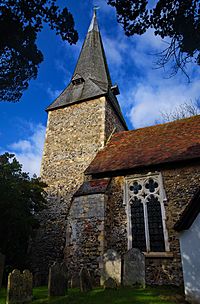Church of St Mary the Virgin, Fordwich facts for kids
Quick facts for kids Church of St Mary the Virgin, Fordwich |
|
|---|---|

Tower of the Church of St Mary the Virgin, Fordwich
|
|
| Lua error in Module:Location_map at line 420: attempt to index field 'wikibase' (a nil value). | |
| OS grid reference | TR 181 598 |
| Location | Fordwich, Kent |
| Country | England |
| Denomination | Anglican |
| Website | Churches Conservation Trust |
| Architecture | |
| Functional status | Redundant |
| Heritage designation | Grade I |
| Designated | 30 January 1967 |
| Architectural type | Church |
| Style | Anglo-Saxon, Norman, Gothic |
| Specifications | |
| Materials | Ragstone, flint and brick Roofs tiled |
The Church of St Mary the Virgin is an old Anglican church located in the small town of Fordwich, Kent, England. It's no longer used for regular church services, which means it's a "redundant church." This special building is protected as a Grade I listed building, which means it's very important historically and architecturally. The Churches Conservation Trust takes care of it. You can find the church close to the center of Fordwich, about 3 kilometers (2 miles) northeast of Canterbury.
Contents
History of the Church
This church was first built around the time of the Norman era. Some parts of the main area, called the nave, even have older Anglo-Saxon materials.
In the 12th century, the chancel (the part of the church where the altar is) and the north aisle (a side section) were added. About a hundred years later, in the 13th century, the chancel was made longer, and the tall tower at the west end of the church was built.
During the 14th century, new windows were put into the south wall. Later, in the 18th century, special enclosed seats called Box pews were added inside. The floor was also covered with tiles. The church stopped holding regular services in 1995. It was then officially given to the Churches Conservation Trust on December 5, 1996, so they could look after it.
Church Architecture and Design
Outside the Church
St Mary's Church is built using a mix of different stones, like ragstone, along with flint and brick. Some parts of the outside are also covered with a smooth plaster called stucco. The roofs are made of tiles.
The church's layout includes a main area (the nave), a side section (the north aisle), and a small entrance area (the south porch). It also has the chancel and a tall tower at the west end. The tower has a pointed roof called a broach spire, which is covered with wooden shingles. The porch is made with a wooden frame.
You can see two narrow Anglo-Saxon windows in the north aisle. There's also a window from 1503 with three sections. In the chancel, there are two windows from the 13th century and a larger one from the 15th century. The windows in the nave have decorative shapes at the top that look like four-leaf clovers, called quatrefoil heads.
Inside the Church
If you look closely, you might notice that the ground under the archway (called an arcade) between the nave and the aisle has settled a bit, making the arches lean. At the bottom of the tower, there's a special shelf that was once used for bread.
The 18th-century box pews are still in the church. In the front corner of the nave, there's a special "civic pew." This pew has a fancy wrought iron stand that used to hold the mayor's mace (a special staff). Above this pew, there's a decorative shield-like shape called a cartouche with the Cinque Port Arms on it.
The large font, where baptisms take place, stands between the nave and the aisle. It's in the Norman style and has carvings that look like blank arches. It's made from a type of stone called Bethersden marble and has a wooden cover from the 17th century.
Above the arch leading into the chancel, you can see the Royal arms from 1688, belonging to King James II. On either side of the east window, there are boards with the Ten Commandments and the Lord's Prayer written on them.
The colorful stained glass in the east window was made in the 20th century. It was designed by Martin Travers to remember a rector (a church leader) who passed away in 1931. The windows in the nave have older medieval stained glass. These show scenes like the Coronation of the Virgin, the Virgin Mary and Child, and the symbols of Saint Mark and Saint Luke.
You can also find a brass plaque from 1605 in the nave. There are three hatchments (diamond-shaped boards with coats of arms) in the church, two of which are from the 17th century.
The organ, which has one keyboard (manual), was built by G. M. Holdich and later fixed up in 1899 by Browme. It used to be in St Martin's Church, Canterbury and was moved here in 1908. The church also has a set of four bells. All of them were made by Joseph Hatch, one in 1624 and the other three in 1633. These bells are no longer able to be rung.
The Fordwich Stone
In the north aisle, there is a large block of limestone that stands about 1.7 meters (5.5 feet) tall. It's carved to look like a tomb. This stone dates back to around 1100 and is thought to have been the shrine of a saint.
No one knows exactly how long it was in the church. It was moved from the church to Canterbury Cathedral in 1760 but was brought back to Fordwich in 1877. Some people believe it might have been part of the shrine of Saint Augustine of Canterbury.
See also


